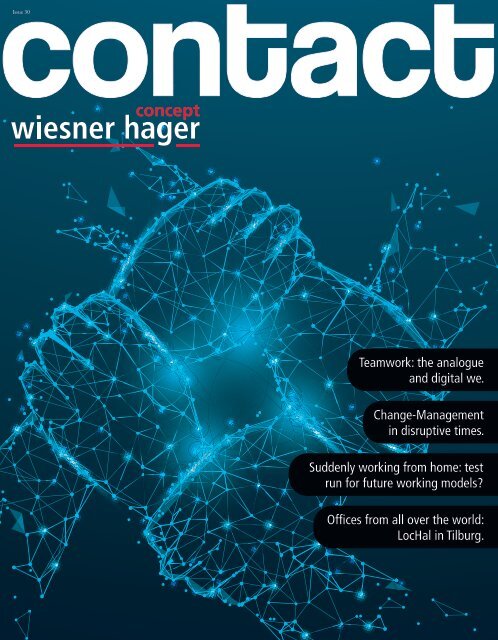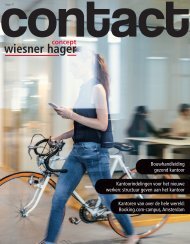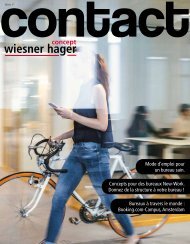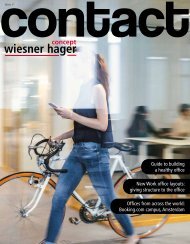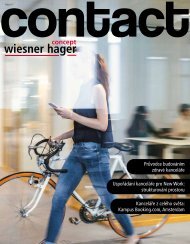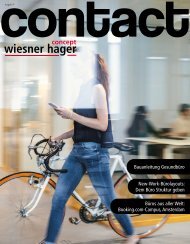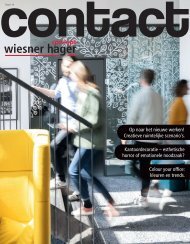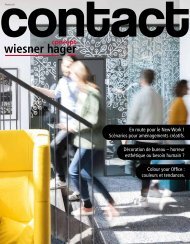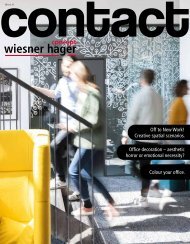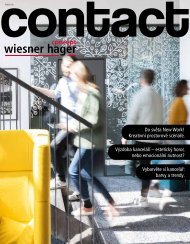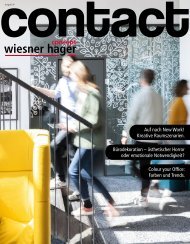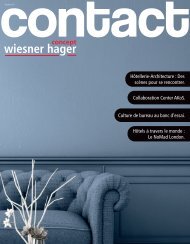contact office magazine #30
The fact is: COVID-19 has turned organisations’ playbooks upside down. Well thought-out, step-by-step change management processes are currently pipe dreams – many decisions have to be made overnight now. In our cover story, we take a close look at how team play and team leadership work during an extreme crisis like the one we are experiencing now and what insights we can preserve for the future.
The fact is: COVID-19 has turned organisations’ playbooks upside down. Well thought-out, step-by-step change management processes are currently pipe dreams – many decisions have to be made overnight now. In our cover story, we take a close look at how team play and team leadership work during an extreme crisis like the one we are experiencing now and what insights we can preserve for the future.
Create successful ePaper yourself
Turn your PDF publications into a flip-book with our unique Google optimized e-Paper software.
Issue 30<br />
Teamwork: the analogue<br />
and digital we.<br />
Change-Management<br />
in disruptive times.<br />
Suddenly working from home: test<br />
run for future working models?<br />
Offices from all over the world:<br />
LocHal in Tilburg.
A guide for difficult<br />
times.<br />
Of course the virus has also reached the latest edition of our Contact<br />
– fortunately in a positive sense. It ultimately offers a series of constructive<br />
thoughts, information and tips for, during and after corona.<br />
In our cover story, we take a close look at how team play and team<br />
leadership work during an extreme crisis like the one we are experiencing<br />
now and what insights we can preserve for the future.<br />
The fact is: COVID-19 has turned organisations’ playbooks upside<br />
down. Well thought-out, step-by-step change management processes<br />
are currently pipe dreams – many decisions have to be made<br />
overnight now. Read an exciting interview with Christian Vieira dos<br />
Santos, Managing Director of SYMBIOS and expert for Change-<br />
Management & Transformation on this.<br />
We are also doing a test run for future working models, addressing<br />
the often invoked but rarely spatially implemented team <strong>office</strong>, showing<br />
three examples of how shared <strong>office</strong>s can be practised, as well as<br />
having rethought conference rooms for you.<br />
Afterwards we take a look at renowned residential construction<br />
specialist Stephan Gratzer’s desk and visit perhaps the most beautiful<br />
and unusual revitalisation project in Europe: LocHal in Tilburg, the<br />
Netherlands. I am delighted that we can offer you a real guide with<br />
this issue of Contact!<br />
Be inspired and stay healthy.<br />
Markus Wiesner
Teamwork: the analogue and digital we ............................................................................04<br />
Team <strong>office</strong>s: Demand and reality ......................................................................................08<br />
Interview: Change management in disruptive times ..........................................................10<br />
Shared Offices: from private to public space ......................................................................12<br />
Useful things for everyday <strong>office</strong> life ..................................................................................14<br />
Reference story: Smart workplace solution by & for ACP TEKAEF ......................................15<br />
Suddenly working from home: Test run for future working models? ..................................18<br />
Offices from all over the world: LocHal in Tilburg, the Netherlands ....................................20<br />
What‘s on your desk, Stephan Gratzer? .............................................................................23<br />
The „Boomer“ at work ......................................................................................................24<br />
Showroom .........................................................................................................................26<br />
Publisher: Wiesner-Hager Möbel GmbH, Linzer Straße 22, A-4950 Altheim, T +43/(0)7723/460-0, altheim@wiesner-hager.com,<br />
www.wiesner-hager.com, thinknewwork.com; Concept/editing: Wiesner-Hager, plenos creative; Layout: plenos creative, plenos.at;<br />
Guest author: Wojciech Czaja; Subject to typesetting & printing errors; 05/2020.
Office concepts<br />
Teamwork:<br />
The analogue and<br />
digital we.<br />
How do team play and team leadership work in times of corona? What are the main differences<br />
between analogue and digital communication? And which findings from the current crisis, but also<br />
from labour research in the past can we preserve for the future? A story about slack, commitment<br />
and online after-work beers.<br />
4 <strong>contact</strong>
“We can talk on the phone tomorrow, sometime<br />
between 9 a.m. and 4 p.m., and then you can ask me<br />
your questions”, says Jens Kapitzky, “but<br />
unfortunately, we can‘t do that today. It‘s just after 5<br />
p.m., and my team and I are already in the middle of<br />
our online after-work beers. We’re calling it a day”. All<br />
right, cheers and goodbye! See you tomorrow! The<br />
phone call is over.<br />
Kapitzky is an organisational and strategic consultant<br />
and heads the Metaplan Leadership & Organization<br />
Academy in Quickborn near Hamburg. As with most<br />
companies in April, the German head <strong>office</strong> and the<br />
branches in Zurich, Princeton, Versailles, Singapore<br />
and Shanghai are currently closed, and most of the<br />
approximately 65 employees are working<br />
from home. Every day at 5 p.m. Central<br />
European Time, they meet virtually<br />
and treat themselves to a glass of beer or<br />
pint or panaché – or even a Far Eastern<br />
midnight drink. “Teleworking has been<br />
on our agenda for several weeks now”,<br />
says Kapitzky the next morning, “and<br />
although we have been used to remote<br />
working for years, there is a significant<br />
difference between communicating with<br />
each other virtually, or in fact<br />
exclusively, as is currently the case. If<br />
there are no other possibilities for<br />
informal meetings, chatting at the coffee<br />
machine or having lunch together in the<br />
cafeteria or canteen, then you have to react<br />
flexibly to the situation and proactively introduce<br />
substitute rituals”. Top priority: professional matters<br />
are only spoken about in a rudimentary way during<br />
online after-work beers, and if so, then only funny<br />
stories and anecdotes.<br />
“For weeks the phone has been ringing off the hook,<br />
one video conference after another, hundreds of emails<br />
a day, as companies from all sectors find out how they<br />
can manage their teams efficiently and facilitate<br />
collaboration in times of the corona crisis and<br />
teleworking”. Kapitzky explains that customers<br />
include trade fair and event organisers, machine<br />
builders, pharmaceutical companies and educational<br />
institutions – both large companies and SMEs and<br />
individual entrepreneurs who are considering how<br />
The management<br />
role becomes more<br />
complex with<br />
distance.<br />
best to take their services online in this era of social<br />
distancing. Kapitzky also heads brand eins safari,<br />
where he teaches the differences between analogue<br />
and digital leadership management in the form of<br />
Learning Nuggets webinars on behalf of the German<br />
business <strong>magazine</strong>.<br />
“May I be completely honest? The world is full of crap<br />
meetings that take up a lot of time, have no<br />
measurable results and make you feel like you are<br />
falling into a black hole as life rushes by. And these<br />
meetings that are so crap when you attend them in<br />
person, are just as crap in remote mode”. Kapitzky<br />
demands: “Clear rules of the game are required as to<br />
what a meeting is for, how long it should last, who<br />
is going to lead the discussion, what<br />
result is to be achieved and who is<br />
going to implement and carry out the<br />
agreed points, to what extent and by<br />
when. If this distribution of roles is not<br />
clear, then the consequences in remote<br />
working are even more tremendous than<br />
in everyday work when you are actually<br />
physically present, because the<br />
management role becomes more<br />
complex with distance”. What helps:<br />
training sessions for meeting hosts,<br />
ideally also the introduction of a<br />
separate moderator role.<br />
A study conducted in 2019 by the<br />
globally active ADP Research Institute<br />
(ADPRI) proves that such orchestrated teamwork in<br />
teleworking is not necessarily a disadvantage<br />
compared to the traditional <strong>office</strong> with physical presence.<br />
The study analysed the involvement of a total of<br />
19,000 workers around the world, with a<br />
representative sample of 1,000 workers in 19<br />
countries. The result is surprising, if not positively<br />
shocking. Firstly: the commitment increases<br />
exponentially with the ability to work in a team and<br />
the trust in the team leader. While only eight percent<br />
of all the employees surveyed working without a team<br />
said that they feel fully committed, the commitment<br />
in a team already rises to 17 percent. At the top with<br />
45 percent commitment are all those who work in a<br />
team with good confidence in the team leader. And<br />
secondly: the more often and more intensively<br />
© Shutterstock<br />
<strong>contact</strong> 5
Office Concepts<br />
employees work away from home or on business trips,<br />
the more committed they are to their work. While<br />
employees with a permanent physical presence in the<br />
<strong>office</strong> are only 12 percent fully committed, the<br />
commitment increases to twice that with four or even<br />
five days of teleworking per week.<br />
“The rise of the gig economy has raised concerns about<br />
the social isolation of gig workers”, write Marcus<br />
Buckingham, research director and co-managing<br />
director at the ADP Research Institute, and Ashley<br />
Goodall, senior vice president at U.S. telecom<br />
company Cisco, in a recent article in Harvard Business<br />
Manager. “However, the ADPRI study shows that<br />
this way of working actually encourages commitment<br />
more than the traditional model. The results show<br />
that gig-work can not only be very<br />
appealing, but also contains elements that<br />
we can integrate into our<br />
traditional work”.<br />
In plain language, Buckingham and<br />
Goodall continue in their documentation,<br />
this means: ”Employees should be able<br />
to exercise more control over their work<br />
and have more opportunities to do things<br />
that inspire them. They should be able to<br />
combine the best of both worlds –<br />
a predictable, stable role in a home team<br />
and a part-time job in the form of various<br />
opportunities to join dynamic teams within<br />
the same company”. For this<br />
communication and leadership culture to gain a<br />
foothold, it is not only necessary to have good,<br />
empathic team leadership, but also a clear allocation of<br />
roles in the team and equally clear feedback rules with<br />
attention and appropriate appreciation.<br />
Anachronistically, a role model that was developed almost<br />
five decades ago and that deals with the question<br />
of how to put together a perfect team comes into play<br />
here. The British researcher and<br />
management consultant Raymond Meredith Belbin,<br />
who has been researching this topic since the 1970s,<br />
assumes that people behave differently depending<br />
on their personality traits and take on a typical role<br />
according to their abilities and habitus. Belbin defines<br />
three categories, each with three matching team roles:<br />
The action oriented roles include shaper, implementer<br />
and perfectionist. The people oriented roles include<br />
coordinator, team worker and resource investigator.<br />
And the cerebral roles are made up of deviser, monitor<br />
evaluator and specialist.<br />
Virtual space demands<br />
and prmotes<br />
self-organised<br />
work.<br />
“Belbin‘s role model is still relevant today”, says<br />
Viennese industrial and organisational psychologist<br />
Bettina Wegleiter. “And I find it fascinating that his<br />
model continues to be used as an important basis,<br />
even with disruptive upheaval such as digitalisation,<br />
the corona crisis and changes in usual wor Isuk and<br />
communication processes. Especially in times of<br />
teleworking, digital communication and disembodied<br />
team leadership using Zoom, Moodle, Slack, Webex<br />
and MS Teams, Belbin‘s model is a very useful and<br />
helpful orientation for putting together harmonious,<br />
efficient and productive work and project teams”. But<br />
Wegleiter does see a change to the seventies: “In<br />
contrast to the past, it is not the constants who win<br />
today, but all those who are able to swap roles and<br />
switch back and forth between different team roles,<br />
like in holacracy”. This<br />
flexibility and elasticity is indispensable,<br />
particularly in the new working world,<br />
says the psychologist, because it makes<br />
a difference whether you are physically<br />
on site, whether you are contributing to<br />
a video conference with a show of hands<br />
or whether you are expressing a creative<br />
idea during an informal meeting in the<br />
corridor. “Virtual space demands and<br />
promotes self-organised work. The bigger<br />
and more extensive your role repertoire,<br />
the faster you can integrate into the team,<br />
the better prepared you are for the work of<br />
the future”.<br />
The Viennese furniture and product designer Thomas<br />
Feichtner is looking at how the previous findings<br />
and achievements in the field of team play and team<br />
leadership, as well as the current corona crisis, will be<br />
reflected on the job market. “The way teams function<br />
and how they are managed in the best possible way<br />
is currently involuntarily undergoing a complete<br />
upheaval. We are working differently, communicating<br />
differently, moving differently, and our attitude<br />
towards the classic <strong>office</strong> is changing as a result. This<br />
will have an impact on furniture, on <strong>office</strong> design<br />
and most likely even on the residential and <strong>office</strong> real<br />
estate market post-corona”.<br />
We are able to work efficiently and productively from<br />
home. As the ADP Research Institute has<br />
emphatically demonstrated, we are doing this with a<br />
comparatively high level of commitment. And<br />
indispensable work qualities such as team spirit and<br />
the ability to work in a team can be surprisingly<br />
6 <strong>contact</strong>
maintained even without a permanent physical<br />
presence, assuming good leadership. “So perhaps the<br />
<strong>office</strong> of the future will be an <strong>office</strong> base with a lounge,<br />
coffee house and a few work cells for concentrated<br />
work, if someone is going stir-crazy working from<br />
home with their children and partners around”, says<br />
Feichtner. “Perhaps the <strong>office</strong> of tomorrow will serve<br />
less as a workplace and more as a social meeting place<br />
to discuss work tasks and personal anecdotes – and<br />
perhaps just to celebrate a real evening together once a<br />
week with a real beer”.<br />
Wojciech Czaja<br />
© Shutterstock<br />
<strong>contact</strong> 7
Interior design<br />
© Visualisierung: Studio Perspektiv<br />
More than just a room to work in:<br />
team <strong>office</strong>s<br />
Demand and reality.<br />
Collaboration before confidentiality.<br />
Open-plan <strong>office</strong>, combi <strong>office</strong>, management<br />
<strong>office</strong> and cellular <strong>office</strong>. The notions of what<br />
is meant by the different types of <strong>office</strong>s vary<br />
widely. After all, the types of <strong>office</strong>s used in<br />
a company are as varied as the areas of responsibility.<br />
In this article we take a look at<br />
the often quoted but rarely spatially realised<br />
team <strong>office</strong>.<br />
As different as team <strong>office</strong>s are designed in companies,<br />
depending on the respective area, this type of <strong>office</strong> has<br />
some basic things in common that characterise it as<br />
such. Cooperation and communication are paramount,<br />
the work processes are geared towards collaboration.<br />
Efficient working in a team <strong>office</strong> means short<br />
communication channels and instantly sharing<br />
information. Team members should therefore also<br />
work together in the same space. Open-plan or cellular<br />
<strong>office</strong>s are not suitable for this purpose, but „open<br />
units“ - small-structured, yet open zones - are called for.<br />
These are visually and acoustically shielded to a greater<br />
or lesser extent depending on the area and purpose.<br />
The shielding from the outside should be chosen in<br />
8 <strong>contact</strong>
such a way that concentrated team and project work<br />
is guaranteed. For reasons of efficiency, the number of<br />
employees who share a common workspace in the team<br />
<strong>office</strong> is 20 people at the most. They need the<br />
opportunity to share information quickly and to easily<br />
keep up to date.<br />
A team <strong>office</strong> must offer more than just a place to<br />
work. The focus is on cooperation and requires the<br />
appropriate support in terms of space and equipment.<br />
The aim is to provide an environment that is geared<br />
to the team‘s tasks entirely in line with the principle<br />
of activity-based working: concentrated (team) work,<br />
coordination and communication or creative<br />
brainstorming. If necessary, an acoustic and visual<br />
retreat should also be available, e.g. in the form of a<br />
telephone booth or a silent room. The workstations are<br />
ideally equipped with electric height-adjustable desks.<br />
This not only increases the ergonomic quality, but also<br />
creates space for coordinative, spontaneous<br />
conversations while standing. Teams are also supported<br />
by digital workspaces. The shared (team) cloud often<br />
takes over the storage space function in the form of<br />
shared storage locations. Metres and metres of wall<br />
units are a thing of the past – at least in team <strong>office</strong>s.<br />
Scrum gives the team <strong>office</strong> a new dynamic.<br />
Integrated or separate communication areas should<br />
facilitate the high demand for internal coordination<br />
within the team. Contemporary multimedia<br />
equipment also envisages flip charts and pin boards<br />
for creative exchange. One meeting is hot on the heels<br />
of the next one with Scrum teams in particular. With<br />
this agile working method, the team <strong>office</strong> virtually<br />
becomes a project <strong>office</strong> with flexible settings, which<br />
can take place with different team members depending<br />
on the project phase. This also requires the flexible<br />
adaptability of space and furnishings. There are no<br />
limits to the creativity of the design: high tables for<br />
short meetings, media furniture for brainstorming<br />
sessions and middle zones equipped with upholstered<br />
furniture or tables and benches that are also used for<br />
team meetings and lunches together.<br />
Clear rules of the game are required for<br />
cooperation.<br />
The openness of this type of <strong>office</strong> and the subjective<br />
perception of the team members also poses challenges<br />
for the <strong>office</strong> space, which are best solved at the <strong>office</strong><br />
design stage: acoustic and climatic comfort must be<br />
created for the whole team. On the one hand, this<br />
requires structural measures, on the other hand it also<br />
requires rules and a willingness to compromise for each<br />
individual employee.<br />
In general, people’s conduct plays a crucial role for a<br />
successful team: it brings together individuals with<br />
different experiences and needs. What constitutes a<br />
team’s strength under normal circumstances can<br />
quickly become a weakness if employees do not get<br />
along well with each other. Ongoing disputes and<br />
friction put cooperation within the entire team at risk<br />
– even the best <strong>office</strong> space is of no use then. Inconsistencies<br />
should therefore be addressed at an early<br />
stage and ideally be cleared up with the help of team<br />
coaching, before the work together is affected and the<br />
entire team suffers.<br />
<strong>contact</strong> 9
Interview<br />
Change management<br />
in disruptive times:<br />
© shutterstock<br />
What we can learn from COVID-19 for the design of new working environments.<br />
COVID-19 suddenly turned the rules of the game upside down for organisations. The consequences<br />
will be felt for a long time to come. Instead of introducing processes and changes step by step into the<br />
corporate culture, changes have to happen overnight in exceptional situations. We asked Christian Vieira<br />
dos Santos, CEO of SYMBIOS and expert for transformation processes in new working environments, for<br />
an interview.<br />
During the worldwide corona crisis, many companies<br />
have reached their limits and are operating in<br />
„emergency mode“. Is there any way to prepare for such a<br />
horror scenario?<br />
The corona crisis is making many things that were<br />
there before even clearer. It‘s like being under a<br />
magnifying glass. Corona has clearly shown us how<br />
interconnected, complex and dynamic our world is.<br />
Dynamics describes nothing other than the<br />
probability of being confronted with surprises.<br />
Something is complex, on the other hand, when simple<br />
solutions no longer work on the basis of „if-then“<br />
relationships. So in the sense of: If A happens, I have<br />
to do B to get C. Corona is both. Dynamic and<br />
complex. It appeared unexpectedly and cannot be<br />
solved using simple responses.<br />
Our current organisations are not designed for<br />
dynamics and complexity. On the contrary, they are<br />
based on predictability, plannability and stability. In<br />
an environment that cannot be planned because it is<br />
full of surprises, these forms of leadership and organisation<br />
no longer work. The systems that brought us<br />
prosperity in the 20th century are failing in the 21st<br />
century.<br />
10 <strong>contact</strong>
How can companies respond to dynamics and complexity?<br />
In the meantime, we are aware of good solutions for<br />
how we have to design leadership, organisation and<br />
cooperation so we can master dynamics and complexity<br />
better. That‘s what New Work and agile do best. Instead<br />
of planning, centralised control and processes based on<br />
the division of labour, there is a need for adaptability<br />
(agility), creative problem solving and the ability to<br />
organise yourself independently. Corona therefore offers<br />
us a great learning opportunity to develop these skills, so<br />
we can deal with dynamic events and complex problems<br />
better in future.<br />
What do you think companies can do in<br />
concrete terms to seize this opportunity?<br />
The corona crisis, for example, has meant<br />
that even the most hesitant company has<br />
had to switch to virtual collaboration. And<br />
this happened overnight, without any long<br />
negotiation processes through working<br />
from home regulations. In many cases,<br />
companies also had to find creative solutions<br />
to make this possible from one day<br />
to the next. That was agility in its purest<br />
form. These companies then also realised<br />
that you can trust your employees to work independently,<br />
even if you only see each other from time to time by<br />
video conferencing.<br />
Corona has shown that many tasks can also be done<br />
remotely using video conferences and collaboration<br />
tools. Will we even need <strong>office</strong>s at all in the future?<br />
Corona acts like a magnifying glass here too. Because<br />
even before corona, more and more companies<br />
recognised the importance of the <strong>office</strong> for corporate<br />
culture. Corona is showing us that much more work can<br />
be done remotely and independently of location and<br />
time constraints. This offers, for example, a great<br />
opportunity to reduce business and commuter traffic in<br />
future. But corona is also showing us how<br />
important social exchange is for us humans. The <strong>office</strong><br />
will therefore become a place of lively interaction even<br />
more so than before. A place where a sense of<br />
community, team spirit and cultural identity<br />
are made possible.<br />
What is important to integrate this newly<br />
acquired knowledge into a normal working<br />
day and not fall back into our „old rut“<br />
again?<br />
In my opinion, relapsing into old patterns of<br />
behaviour should not be underestimated. We<br />
Corona offers<br />
learning<br />
opportunitites for<br />
the future.<br />
are familiar with this effect from courses, for example:<br />
the different environment in a seminar creates a different<br />
context that makes something new possible. Once this<br />
context disappears again, the old routines quickly creep<br />
in again. Companies should therefore ask themselves<br />
which learning experiences from the corona period can<br />
become the new norm in everyday life.<br />
What kind of people are needed to steer change in the right<br />
direction?<br />
Self-organisation, personal responsibility,<br />
interdisciplinary problem-solving<br />
competence and the ability to change need<br />
a completely new way of thinking, a new<br />
mindset or consciousness. In my opinion,<br />
this is one of the major tasks facing managers<br />
today. To create an environment in which<br />
employees and the entire organisation can<br />
develop these skills. If this is successful,<br />
corona will also have done some good.<br />
We human beings are born as highly creative<br />
beings who want nothing more than to grow<br />
beyond ourselves independently and in<br />
cooperation with other people. Every human<br />
being therefore innately has exactly the<br />
prerequisites that we need in future. Unfortunately,<br />
many people have unlearned these natural abilities from<br />
infancy to adulthood. Therefore this is one of the great<br />
tasks facing managers today: to create an environment in<br />
which these skills can flourish again.<br />
© SYMBIOS<br />
Christian Vieira dos Santos<br />
Founder of SYMBIOS, expert for transformation processes<br />
and new working environments<br />
Christian Vieira dos Santos has been working in the<br />
fields of organisational development and consulting<br />
for 25 years. With SYMBIOS, he supports companies<br />
in transitioning into the new world of work and<br />
designing new working environments.<br />
<strong>contact</strong> 11
Office concepts<br />
Shared Offices.<br />
from private to public space.<br />
Strictly private! Confidentiality, privacy and the security of their buildings or rental properties go<br />
without saying for most companies. After all, who wants to show their business hand?<br />
Nevertheless, the dogma of absolutely protected company buildings and <strong>office</strong> spaces is about to be<br />
broken down. Companies and organisations are increasingly offering „shared <strong>office</strong>s“, which create<br />
a partial public sphere. We show you how this can be implemented in practice using three examples.<br />
12 <strong>contact</strong>
Creative breeding grounds.<br />
Little space available and high rents are increasingly<br />
leading to several companies sharing <strong>office</strong> space in<br />
partnership. The internal organisation for this requires<br />
a zoning concept that combines shared areas such as<br />
a working café, small kitchen or meeting rooms with<br />
clearly assigned work areas, so that each company can<br />
also preserve its privacy.<br />
The Dutch company Broeinest has just opened its<br />
fourth location in Utrecht. Broeinest, in English<br />
„breeding ground”, is a crossover concept consisting<br />
of an <strong>office</strong>, showroom, coworking and creative space.<br />
Broeinest leases to partner companies that share the<br />
premises. It also showcases itself to external architects,<br />
who can use the creative breeding ground as a playground<br />
for material tests, interior products or tools.<br />
Designerwerkschau in Munich is similarly organised.<br />
As a shared showroom, it opens its doors to an<br />
audience interested in architecture and design and<br />
organises a series of events on its premises.<br />
Coworking spaces.<br />
Originally, the trend towards coworking was intended<br />
as a modern and cost-effective <strong>contact</strong> point for<br />
freelancers and start-ups: people who do not work<br />
together directly, but who can use mutual synergies<br />
through the shared and inspiring workspace. At the<br />
same time it forms a community, fulfilling the<br />
important social tasks of people being together. This<br />
community spirit is clearly evident in the Czech Impact<br />
HUB. The coworking centre in the heart of Prague has<br />
been a <strong>contact</strong> point for aspiring start-ups for many<br />
years.<br />
In the meantime, more and more companies are setting<br />
up and using their own coworking spaces, even within<br />
their own organisations: They allow employees to work<br />
together with external freelancers and crowd workers,<br />
form temporary project teams and create retreats for<br />
meetings. Collaboration is encouraged and the spontaneous<br />
sharing of ideas is virtually stimulated!<br />
Coworking spaces offer a lot of freedom in terms of<br />
design: industrial style or living room, lounge or open<br />
space, creative landscape or urban marketplace.<br />
Reinterpreted foyer areas.<br />
Foyers and entrance areas are taking on a completely<br />
new meaning more and more often, especially at larger<br />
company locations. They are being made „public“ and<br />
available to an external audience. The classic reception<br />
area is transformed into a working café. The reception<br />
counter, a bar. Instead of „sitting and waiting“ it’s now<br />
„meeting and working“. The „café entrance“ is a public<br />
zone – how public, that‘s something every company<br />
decides for itself. Guests and business partners, such as<br />
suppliers or customers, can make themselves<br />
comfortable here, spend time and prepare for their next<br />
appointment. Some companies even go one step further<br />
and open the entrance bar area to visitors who have<br />
nothing to do with the company. What‘s the point?<br />
Networking and branding, for example. Extended by a<br />
campus area, the foyer quickly becomes a fully-fledged<br />
event location.<br />
© Visualisierung: Studio Perspektiv<br />
<strong>contact</strong> 13
Trend watching<br />
Useful things for<br />
everyday <strong>office</strong> life<br />
(and working from home).<br />
ROXXANE.<br />
© Microsoft<br />
The Roxxane cordless<br />
table or floor lamp with<br />
integrated rechargeable<br />
battery offers a wide range<br />
of applications and is easy to<br />
transport. This makes it the<br />
perfect companion in <strong>office</strong>s<br />
and also illuminates darker<br />
corners in central zones and<br />
lounges. The light can also be<br />
adjusted to the time of day by touch<br />
using the integrated light control.<br />
Manufacturer: nimbus<br />
© nimbus<br />
Microsoft Teams.<br />
As part of Office 365, MS Teams offers everything your virtual conference room needs: from a classic<br />
schedule overview to a messenger and video chat function to simple file sharing and various additional<br />
features. It is intuitive to user and the user interface is very clear and clean. As a result, MS Teams is also a<br />
pleasant business tool for newcomers to working at home.<br />
© LINTEX<br />
NOTE WHITEBOARD.<br />
Note Whiteboard is a versatile, mobile writing tablet that can be<br />
carried easily thanks to its lightweight construction. Both sides are<br />
magnetic and can be written on. The Note Whiteboard is therefore<br />
the ideal companion for project groups and Scrum teams in creative<br />
meetings and spontaneous brainstorming sessions.<br />
Manufacturer: Lintex<br />
14 <strong>contact</strong>
Reference story<br />
Smart Workplace Solutions<br />
by & for ACP TEKAEF<br />
At first glance, an <strong>office</strong> furniture manufacturer and a company for print and<br />
digitalisation solutions do not seem to have much in common. But the truth is that<br />
Wiesner-Hager and ACP TEKAEF not only have their roots in the same region, but<br />
also share the same mission: modern and flexible workplace design. No wonder<br />
that ACP TEKAEF chose interior design and <strong>office</strong> furniture from Wiesner-Hager<br />
for their new company head <strong>office</strong>.<br />
© www.raumpixel.at<br />
<strong>contact</strong> 15
© www.raumpixel.at<br />
Reference story<br />
© www.raumpixel.at<br />
ACP TEKAEF is a market leader in intelligent<br />
solutions, products and services for the modern<br />
workplace, with 4,800 active customers and 75<br />
employees.<br />
The company offers a complete portfolio in the areas<br />
of print, workplace and mobility management. As<br />
an innovative partner, it supports its customers in<br />
designing work processes flexibly. ACP TEKAEF<br />
primarily commissioned regional companies for<br />
the new building in Hohenzell, Upper Austria. The<br />
construction planning and management was carried<br />
out by the architecture firm Arev, while the interior<br />
design was entrusted to the <strong>office</strong> consulting<br />
company Roomware.<br />
Turning old into new.<br />
The company founded in 1994 has grown strongly<br />
in recent years. The company was therefore looking<br />
for a new location that could meet the demand for a<br />
New Work working environment. A former factory<br />
building in Hohenzell proved to be the perfect place<br />
for this. While the three existing warehouses were<br />
adapted for the company‘s own purposes, it was<br />
decided to demolish the old <strong>office</strong> building. The new<br />
administration building was to be built here. The<br />
<strong>office</strong> building was designed for 100 employees to<br />
enable further growth.<br />
The spacious reception area is impressive, as it has<br />
been extended by an auditorium with a striking staircase.<br />
In the style of a university campus, it functions<br />
as a meeting area for employees and guests and offers<br />
space for events. There are conference and meeting<br />
rooms as well as individually designed working<br />
cafés, a canteen area, a spacious terrace and of course<br />
workstations over three floors. These were equipped<br />
with ergonomic, electric height-adjustable desks. In<br />
between, niche areas were created on all three floors<br />
for collaboration and short meetings – supported<br />
by high tables, seating groups and lounge furniture.<br />
These were designed as working cafés with integrated<br />
small libraries, which allow for both concentrated<br />
work and confidential meetings. Cleverly used<br />
bookshelves and laser-cut solid surface walls act as<br />
room dividers.<br />
A multifunctional room is available on the ground<br />
floor for larger meetings and seminars. Thanks to the<br />
flexible and mobile furnishing, it is no problem to<br />
react quickly and spontaneously to different usage<br />
requirements. A „Creative Room“ and some smaller<br />
meeting rooms supplement the need for<br />
communication. They have been deliberately kept<br />
small to allow for more effective team meetings.<br />
Interplay between hard and soft.<br />
The high standards that ACP TEKAEF set for the<br />
new location’s design can be seen as soon as you<br />
16 <strong>contact</strong>
enter the building. Hard and soft materials have<br />
been coordinated to create a pleasant lightness and<br />
a feel-good atmosphere. Exposed concrete and hard,<br />
wipeable surfaces alternate with soft textiles and<br />
warm wood tones. The deliberate use of natural<br />
colours and organic forms is a style that runs<br />
through all rooms.<br />
The ceiling suspensions in the form of the company‘s<br />
logo element ensure pleasant acoustics in the<br />
auditorium. This honeycomb shape appears<br />
repeatedly in the room concepts. In addition to<br />
the honeycomb-shaped elements and the angular<br />
columns, the designers used curves, which were<br />
incorporated, for example, into the shape of the<br />
auditorium‘s seat staircase. This design language is<br />
encountered once again in the shelving systems and<br />
in the textile-covered room dividers between the<br />
workstations.<br />
„Bright“ new building for the employees.<br />
Teamwork and employee satisfaction are very<br />
important at ACP TEKAEF. “Our team has made<br />
our business success possible. That is why we are<br />
building the new head <strong>office</strong> for our employees”, said<br />
Managing Director Christian Heit at the<br />
ground-breaking ceremony. It’s no wonder then that<br />
the workforce was happy to volunteer to help with<br />
the company‘s relocation, thus ensuring a smooth<br />
and speedy process in February 2020. The planning<br />
process and construction phase took a total of two<br />
years.<br />
Despite the open spatial structures, each area has<br />
fixed workstations with the necessary task-related<br />
additions. To ensure that this zoning does not<br />
counter the open space concept, transparent glass<br />
cubes and lightweight solid surface partition walls<br />
were used. The lighting concept with a skylight and<br />
an impressive rooftop terrace with large glass fronts<br />
creates a natural ambience flooded with daylight<br />
throughout the building.<br />
ACP TEKAEF paid particular attention to the<br />
regeneration and canteen area. GENUSSwerk<br />
prepares fresh meals for the employees in the open<br />
kitchen every day. Thanks to the pleasant homely<br />
atmosphere, the canteen is also used as a working<br />
café, where employees can meet customers outside<br />
lunchtime.<br />
© www.raumpixel.at<br />
Project space<br />
Office space: 1,200 m²<br />
Building architecture: AREV Architektur<br />
Statics & construction: ZTW Weilhartner<br />
Office concept and<br />
interior design:<br />
Roomware Consulting<br />
Furniture:<br />
Wiesner-Hager,<br />
olina Küche,<br />
Schachreiter Interieur<br />
<strong>contact</strong> 17<br />
© www.raumpixel.at
Office life<br />
Suddenly the home <strong>office</strong><br />
is here: Trial run for<br />
future working models<br />
Drinking a cup of coffee by yourself, going to<br />
the <strong>office</strong> in your pyjamas and taking a shower<br />
during your lunch break. Most of us imagine<br />
the home <strong>office</strong> to be simpler than it actually is.<br />
You suddenly find yourself sitting alone in the<br />
kitchen with your laptop and missing a<br />
comfortable <strong>office</strong> chair to sit on and a chat<br />
with colleagues at the very least.<br />
The current corona crisis doesn‘t tolerate excuses<br />
anymore and is confronting many companies with<br />
the task of making mobile working possible. A large<br />
number of organisations still have a lot of catching up<br />
to do in terms of digitalisation. But many employees<br />
are now sitting at home on the couch with their work<br />
laptop on their knees, despairing of an overloaded<br />
cloud or a server that is much too slow.<br />
Virus protection: for people and PCs<br />
For this reason, many companies have sent their<br />
employees to their home <strong>office</strong> without further ado.<br />
Cyber criminals are having a field day, though, because<br />
the home network rarely offers the same security<br />
standards as the corporate system. To protect<br />
your PC as well as your company from<br />
virus attacks, installing a VPN - a<br />
Virtual Private Network - is<br />
imperative. To ensure an<br />
optimum workflow, the<br />
appropriate hardware and<br />
software must be available in<br />
addition to the VPN. The<br />
motivation to work will be extremely<br />
dampened if, for example, loading<br />
times are too long or files cannot be<br />
opened.<br />
This of course creates an additional<br />
workload for the IT department,<br />
especially in a period of crisis<br />
of the kind we‘re currently<br />
experiencing. But<br />
although the time and<br />
effort involved is<br />
18 <strong>contact</strong>
immense at the start, it defnitely pays off in day-to-day operations.<br />
Team meetings in pyjamas<br />
In the <strong>office</strong>, we‘re always exchanging information as we go about our<br />
business. This natural flow of information is missing in the home <strong>office</strong>. The<br />
best way to keep all employees up to date is to arrange feedback rounds via<br />
video conference. You should also make it clear which channels are to be used<br />
for communication. This way you avoid misunderstandings in communication<br />
and strengthen internal interaction despite physical distance. And as far as the<br />
pyjamas are concerned, though, they may go down well with colleagues, but<br />
they have no place in meetings with customers via video chat.<br />
A trial run for the future?<br />
Alongside all the obstacles and fears that have<br />
overwhelmed us due to exit restrictions and health<br />
regulations, the sudden switch to a home <strong>office</strong> can also<br />
be seen as a trial run for future working models and<br />
crises. Draw up a checklist that answers questions such<br />
as the following:<br />
• Which measures have proved successful?<br />
• Where does technology still have room for<br />
improvement?<br />
• What do you need as an employee to be able to work<br />
productively from home?<br />
• How can communication be improved internally and<br />
with customers?<br />
A feedback form for home <strong>office</strong> employees can also be<br />
helpful in optimising flexible working practices within<br />
the company and preparing for the future.<br />
© shutterstock<br />
<strong>contact</strong> 19
Offices from all over the world<br />
© Arjen Veldt<br />
Coworking between<br />
rust &<br />
patina<br />
Where<br />
locomotives were once built<br />
and repaired, there is now a production<br />
site of knowledge and social<br />
networking. The so-called LocHal in<br />
Tilburg in the Netherlands is one of<br />
the most beautiful and unusual revitalisation<br />
projects in Europe.<br />
20 <strong>contact</strong>
The old layers of paint and varnish stick to the riveted<br />
steel columns, sometimes red, sometimes green,<br />
sometimes magenta, and one is almost inclined to<br />
believe that there is still the smell of soot and heavy<br />
engine oil in the air, as if the last repaired locomotive<br />
had been pushed out of the hall a few minutes ago.<br />
Once upon a time, connecting rods, steam boilers and<br />
iron<br />
bodies weighing tonnes hung from the huge steel<br />
girders at a height of 15 metres, as the black-and-white<br />
photos<br />
framed in metal brackets in the corridors reveal.<br />
The LocHal – an emotional monument.<br />
“The locomotive hall was built in 1932, and there<br />
is probably not a single inhabitant in the whole of<br />
Tilburg who doesn‘t know someone who hasn‘t worked<br />
here at some point, or at least sneaked into the workshop<br />
of the Nederlandse Spoorwegen at night”, says<br />
Gert<br />
Kwekkeboom, partner at the Dutch firm<br />
Civic<br />
Architects. “This hall is an emotional<br />
monument that is firmly anchored in<br />
this city’s collective memory. It was<br />
therefore clear to both the city government<br />
and to us that the building and its<br />
unmistakable character should be<br />
preserved according to all the rules of<br />
architecture and that the new city library<br />
should be located here”.<br />
Where locomotives were once<br />
repaired, welded and screwed, there is<br />
now a workshop for networking and<br />
knowledge transfer. The LocHal, which<br />
If you want<br />
to protect the soul<br />
and the<br />
protective spirit<br />
of the place, you<br />
have to make<br />
compromises.<br />
opened in spring 2019 and whose official<br />
brand can be found on all analogue and<br />
digital channels as a word mark and logo,<br />
not only houses the municipal library,<br />
but also a café, coworking spaces, mixed<br />
media areas and event and conference<br />
rooms in various sizes that can be hired.<br />
All events have been suspended until 1<br />
June due to the current corona crisis, but<br />
a glance at the online calendar shows that<br />
the summer is already well filled with<br />
readings, project presentations and<br />
interdisciplinary think tanks.<br />
© Arjen Veldt<br />
“It was a very enjoyable project, which we worked<br />
intensively on with restorers and the monument<br />
protection authorities”,<br />
recalls Kwekkeboom, who put this unusual mammoth<br />
project on track together with the partner <strong>office</strong>s<br />
Mecanoo and Braaksma & Roos. “The biggest<br />
challenge in all this was undoubtedly the building<br />
services, because such a unique industrial monument<br />
does not allow for thermal insulation, triple glazing and<br />
the usual climate comfort ideas. If you want to protect<br />
the soul and the protective spirit of the place, you have<br />
to make compromises”.<br />
© Arjen Veldt<br />
<strong>contact</strong> 21
Offices from all over the world<br />
The solution: the majority of the hall was designed as<br />
an outdoor space protected from the weather, where<br />
you can sometimes work up a sweat in summer, while<br />
the waiter in the „StadsCafé“ serves you a woollen<br />
blanket in winter if required. Temporary common<br />
areas, such as reading areas, a stage and auditorium, can<br />
be<br />
separated and locally heated or cooled with huge<br />
thermally and acoustically effective curtains hanging<br />
from the steel framework, designed by Amsterdam<br />
fabric artist Petra Blaisse. Only the permanent work<br />
areas such as the coworking <strong>office</strong>s, conference rooms<br />
and the entire administrative organisation are located<br />
in thermally separated house-in-house zones with the<br />
usual indoor temperatures. The heart of the<br />
15-metre high reading and coworking hall is the wide<br />
arena, which connects the upper and lower levels with<br />
stairs and comfortable wooden-clad seating steps. It<br />
seems as if the staircase is in operation almost round<br />
the clock, populated by people who are sometimes<br />
browsing through a brochure or who have sometimes<br />
set up a small, non-territorial <strong>office</strong> with their laptops<br />
and just dialled into the Zoom meeting with headphones.<br />
Nordic and Mediterranean plants hang from<br />
the steel galleries on the side as if in a crumbling palm<br />
house or a shabby-chic industrial jungle. The concept<br />
for this was developed by the Dutch landscape planning<br />
<strong>office</strong><br />
Donkergroen.<br />
reading lamps between the cast-iron pillars and<br />
pilasters, we find the coworking spaces and the<br />
separate, glass-enclosed <strong>office</strong>s of the library staff<br />
employed here. The furniture is brightly coloured with<br />
purple sofas, orange cabinets, and neon lime green<br />
swivel chairs. Through the doors and glass walls you<br />
look out into the world of rust and patina.<br />
During the course of the revitalisation project, the<br />
once 5,000 square metre locomotive hall was more<br />
than doubled to 11,000 square metres using retracted<br />
platforms, surrounding galleries and dramatic stair<br />
landscapes for walking, sitting and lounging. The EUR<br />
18 million building on the site of the former Tilburg<br />
freight station is one of the most beautiful and<br />
sensitive revitalisation projects in Europe, with its<br />
preserved past that has been brought back to the<br />
present. Or, as one visitor noted in the guest book: “A<br />
compliment to the architects and designers of this<br />
building. So creative and inventive, it works so well in<br />
use that it fills you with happiness!”<br />
Wojciech Czaja<br />
© Arjen Veldt<br />
Finally, at the back of the large public hall, where small,<br />
cosy reading and working areas have been set up with<br />
22 <strong>contact</strong>
What’s on your desk?<br />
02<br />
01<br />
03<br />
04<br />
08<br />
05<br />
07<br />
06<br />
09<br />
© Woj<br />
What’s on your desk,<br />
Stephan Gratzer?<br />
In the middle of Geneva city centre, just a few steps away from the large<br />
Plainpalais, there is a factory site steeped in history. Where measuring<br />
instruments were once built for the Societé Genevoise d‘Instruments de<br />
Physique, graphic designers, architects, photographers, advertising agencies<br />
and catering companies now cavort. With MAMCO and the Centre d‘Art<br />
Contemporain, important contemporary and performing arts institutions<br />
are also located here. The <strong>office</strong>s of Jaccaud Spicher Architectes Associés<br />
( JSAA) are located in one of the courtyard buildings, accessible via a narrow<br />
external staircase.<br />
“This is a beautiful, listed industrial building from the 1930s”, says Stephan<br />
Gratzer. The 38-year-old is a partner at JSAA, which specialises primarily in<br />
large-volume, subsidised residential construction in the Geneva area. You<br />
can also see this when you walk through the <strong>office</strong>s: to the left and right of<br />
the centre aisle are architectural models made of wood. To give the viewer<br />
an impression from the perspective of a passer-by, the miniature houses are<br />
propped up on frames and filing cabinets. The effect is tremendous. “The<br />
advantages of an old industrial building are unparalleled. Because of the large<br />
ceiling height, we can afford to position the models higher than is the case in<br />
most <strong>office</strong>s”.<br />
From his own <strong>office</strong>, which he shares with his partners Jean-Paul Jaccaud and<br />
Lionel Spicher, you look down into the former manipulation hall. The old<br />
rails in the ground and the crane hooks, which hang down from steel trusses<br />
like talkative witnesses of that time, create a beautiful background picture.<br />
The iron industrial windows, the unfinished ribbed concrete ceiling and the<br />
walls that were only filled in, not painted, fit in with this.<br />
Wojciech Czaja visits Stephan Gratzer<br />
01<br />
02<br />
03<br />
04<br />
05<br />
06<br />
07<br />
08<br />
09<br />
We love to surround ourselves with art, especially minimalist<br />
art by local and international artists.<br />
The two-part, humorous work by Felix Gonzales-Torres<br />
fits particularly well with our working concept. On the left<br />
picture it says: “Nowhere better than this place”. And on<br />
the right one you can read: “Somewhere better than this<br />
place”.<br />
Our <strong>office</strong> is full of samples, patterns and colour catalogues.<br />
We work with Farrow & Ball paints, wherever possible.<br />
The Anglepoise is a classic British lamp. We have several<br />
dozens of these in the <strong>office</strong> for us and our employees.<br />
I am not a fan of renderings and computer generated<br />
images. We prefer to work with coloured pencils and lead<br />
pencils. This also includes the good old pencil sharpener.<br />
Aquafix and transparent paper are indispensable for our<br />
way of working. The rolls are lying all over the place.<br />
The many incoming and outgoing postmarks also go well<br />
with our analogue work.<br />
We work on Apple computers.<br />
A simple worktop, with a steel table frame by Egon Eiermann<br />
under it.<br />
<strong>contact</strong> 23
Office Life<br />
The „boomer“<br />
at work.<br />
If you don‘t know what the word „boomer“ is all about, there is a good chance that you are a boomer<br />
yourself. Why? The term „boomer“ is based on the common generational definitions and roughly refers<br />
to people from the post-war generations with high birth rates. In other words, those people who were<br />
born between 1950 and the middle of the 1960s.<br />
24 <strong>contact</strong>
Why this well-known fact from sociology is worth a story<br />
of its own to us? Because the so-called boomer generation<br />
represents a not inconsiderable part of the workforce,<br />
especially in the highly qualified professions with an<br />
academic background. Because the general discourse often<br />
revolves around giving younger employees a good start in<br />
working life, but less often around what employers can do<br />
to ensure that older employees also feel integrated in the<br />
company until they retire. Because job satisfaction should<br />
not be a demographic issue. So how do you create a<br />
working environment in which older people feel<br />
comfortable? Some food for thought.<br />
It’s (not) all a question of age.<br />
The most important food for thought for employers: focus<br />
on each employee’s merits and key skills, regardless of<br />
their age.<br />
In general, it can be said that the boomer generation has<br />
experienced the technical development of the last 40 years<br />
and is also fit in analogue culture and working techniques.<br />
This combination can be of huge benefit to everyone<br />
involved in a company. Boomers have a high level of<br />
expertise combined with a great deal of experience.<br />
However, this can be counter-productive in times of<br />
digitalisation and become a stress factor.<br />
After all, digitalisation is almost radically<br />
changing the way knowledge is processed<br />
and communicated.<br />
Many boomers can‘t keep up with this,<br />
quite the contrary: they often insist on<br />
their practices and are reluctant to deal<br />
with the new media and tools. This can be clearly seen in<br />
the current corona crisis with working from home: what<br />
works completely intuitively with no problems for digital<br />
natives, causes difficulties for some of the boomers. They<br />
have to deal with modern cloud-based collaboration tools<br />
that were not essential in the past. But learning by doing<br />
is the best teacher here too. Targeted support from the<br />
employer and active involvement in teamwork is required<br />
– coupled with clear guidelines and a systematic approach.<br />
This is where we come full circle as the boomers are<br />
particularly strong in this respect.<br />
It’s all in the mix.<br />
Each age group has valuable skills for the big picture.<br />
And small teams with a good mix of ages make it possible<br />
to work together productively on equal terms. In best<br />
practice, every employee feels heard and understood. And<br />
no one overtakes or gets left behind. Ideally, all generations<br />
are willing to learn from each other. A meaningful team,<br />
in which everyone feels comfortable, can only be created<br />
through cooperation and exchange. All this is not a<br />
question of age or belonging to a cohort,<br />
but one of respect. And respect is, more than ever before, a<br />
universally valid component in the workplace that should<br />
not be a question of age.<br />
© shutterstock<br />
<strong>contact</strong> 25
Showroom<br />
Reinterpreted<br />
The importance of good communication as a success factor for companies is undisputed. Multimedia<br />
technology and matching conference furniture make an important contribution to the quality of<br />
meetings. With the flexible skill system table range and the charming pulse conference chair,<br />
Wiesner-Hager counters the heaviness of classic conference furniture with lightness of design.<br />
pulse conference chair:<br />
lightness and elegance.<br />
A new four-star swivel base gives the pulse conference chair even more lightness and design<br />
variety. The swivel frame made of high-quality die-cast aluminium is therefore the ideal<br />
companion in conference rooms, where instead of the heaviness of classic boardrooms, the<br />
focus is on modernity – in keeping with the spirit of: understatement is the new important.<br />
With a wide range of fabrics and colours, it can be adapted to any architectural context.<br />
Design: LUCY.D<br />
© wiesnerhager<br />
26 <strong>contact</strong>
conference rooms<br />
skill table system:<br />
the highly flexible conference table system.<br />
The skill table system is characterised by elegance and<br />
visual lightness. In contrast to rigid classic conference<br />
tables, the skill table system allows for a variety of<br />
configurations. The tables can be assembled and<br />
disassembled in just a few steps – without using<br />
any tools at all. A large selection of formats allows<br />
for completely new set-up options, tailored to the<br />
company’s needs. The skill table system demonstrates<br />
its full potential in large scale table configurations<br />
– individually and flexibly adapted to architectural<br />
conditions. The skill table system connects two table<br />
tops with just one frame. This not only accentuates<br />
the light look, but also saves costs, because there<br />
is no need for every second frame. If required, the<br />
elements can also be used as individual tables.<br />
Design: Andreas Krob<br />
© North Sea Port Authority<br />
The frame attached to the underside of the table<br />
top can be removed and latched into the desired<br />
position by releasing the locking mechanism in the<br />
table top support. The frames can be used flexibly: as<br />
an element linking two table tops or as an end piece<br />
flush with the edge.<br />
Click here for the skill animation<br />
<strong>contact</strong> 27
m.zone: The freedom<br />
to choose: Our <strong>office</strong><br />
instead of my desk.<br />
Büro neu denken:<br />
thinknewwork.com<br />
m.zone is a completely new furnishing concept for <strong>office</strong>s, which can be perfectly integrated<br />
into the organisation of agile companies. More on: wiesner-hager.com<br />
Design: Lucy.D


